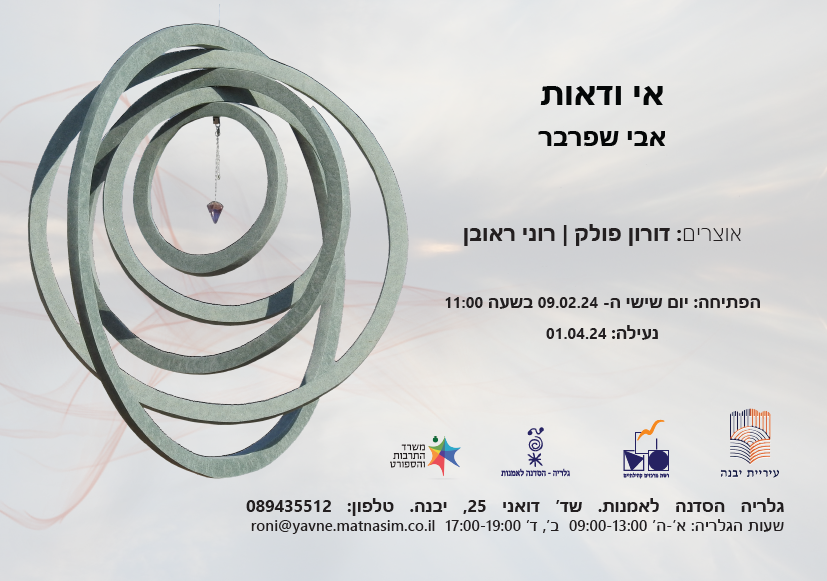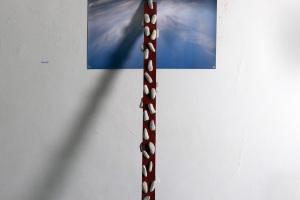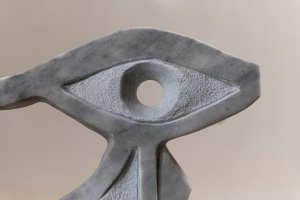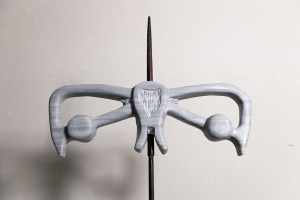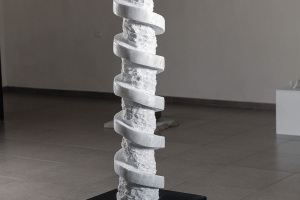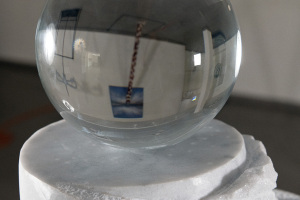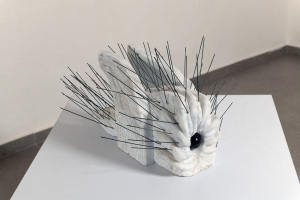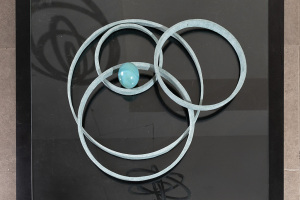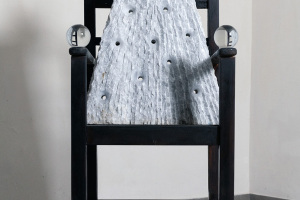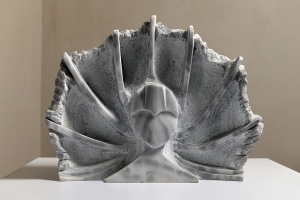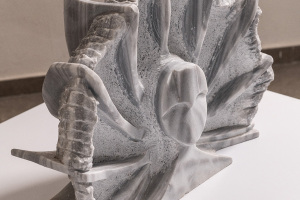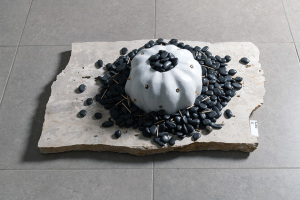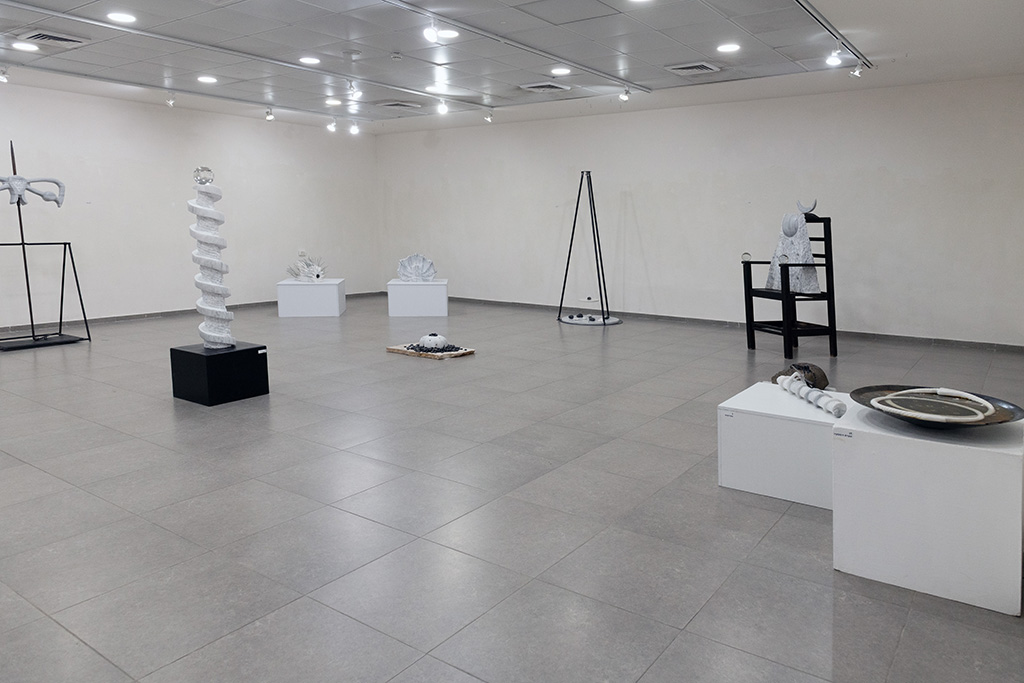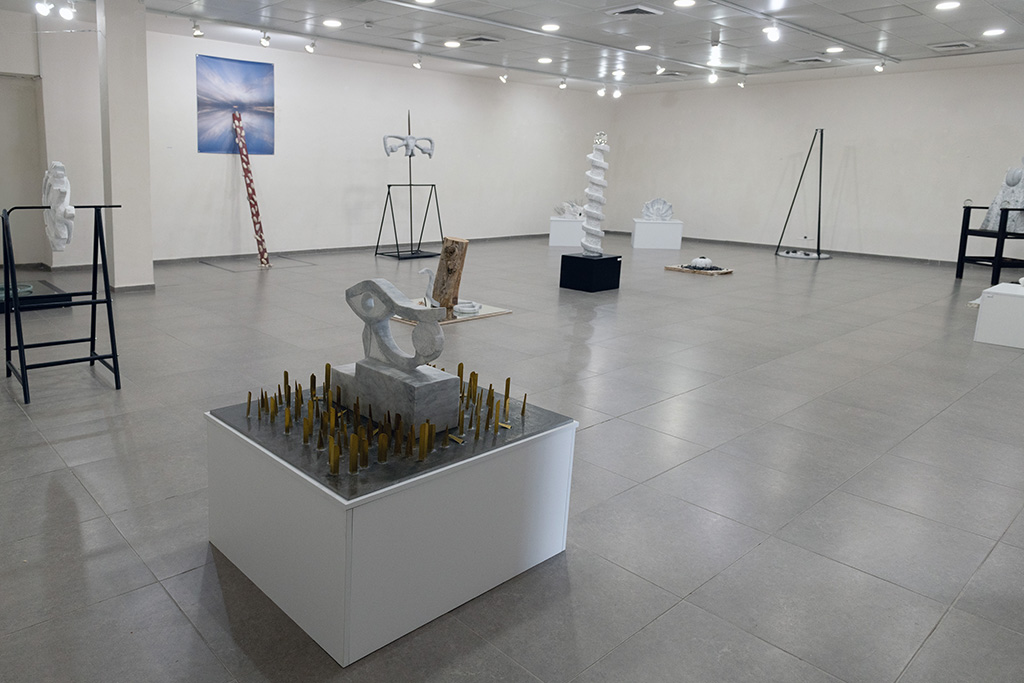Life as Uncertainty
The exhibit titled Uncertainty is being presented at the Yavne municipal gallery during the bloody war in Gaza, a war that has exposed the axis of evil in the Middle East, a charged and timeless war between religions and cultures. There is chilling symbolism in the fact that Avi Sperber sculpts symbols of fate in stone influenced by cultural icons taken from the pages of history. His exhibit enables observing and discussing three-dimensional stone images that may become historical testimony to the horrors of the present, and will endure for future teaching and examination. The themes raised in his work always deal with the conflict between man and nature and between man and man. His images have allegorical meaning that presents a semiotic approach to art – which assumes that cultural symbols exist throughout the generations and do not require explanation or illumination.
This period in Israeli art raises issues of existential anxiety and fear in the here and now. This is the basis of uncertainty, of the dilemma that exists in the heart of man facing wars, problems of life and death, dangers to one’s family and to the world in which he or she lives and works. Each sculpture and installation by Avi Sperber presented in the exhibit represents a cultural symbol teaching about the meaning of the concept of uncertainty and the way to negotiate it through objects, prayers and rituals.
“Avi Sperber is a spontaneous artist. He does thorough research, develops an idea, and one can even get the impression that when he chooses his stone he already sees the finished sculpture in his imagination. It appears that Sperber’s stone sculptures are revealed from within the stone itself – as if they were there all along and that he only removes the covering from them,” curator Debby Luzia writes. Indeed, given the fact that art explores reality, identifies certain patterns in it and translates them into symbols, it is clear that Avi Sperber uses cultural metaphors to connect with various themes.
It is customary to state that works of art are deciphered in relation to their creators. Uncertainty is considered an inseparable part of our lives, as in the expression “Uncertainty is the only certainty.” The universe, which was born out of chaos, was created by separating the waters from the heavens, to create land. Since the dawn of time people have tried to fight chaos by attempting to maintain both a rational order and patterns of thought to define new times while related to the local deity.
Avi Sperber deals with uncertainty and insecurity about the future. Each sculpture in the exhibit provides a ritualistic character whose purpose is to fight the unknown and overcome it – a kind of enchanted primal entity. Such are the works that develop a renewed manifestation of Samael, the mythical satanic archangel, the symbol of cruelty and evil; of his partner Lilith, the prostitute goddess who threatens every woman in childbirth and every newborn child; and of Atropos, the fateful figure that the artist Gustave Doré painted sitting on the roof of the world, inspired by Edgar Allan Poe’s “The Raven”. The exhibit also includes such objects as an incantation bowl, which was used to fight against disease and damage; peyote, which was used to symbolize the prediction of fate; the reception of medicinal properties, and; the ladder, which symbolizes the possibility of rising toward God in the hope of salvation.
Avi Sperber creates each of his exhibits following research, reading and traveling to global centers of culture and archeological sites. For him, creativity is based on a deep process of learning and examination. It is worth noting, regarding uncertainty, that 20th century studies compared artistic practice with the scientific method and found a link between developments in art and in modern physics. Modern sculpture’s critical examination of the means of representing itself has been compared to scientific inquiry. The substantive changes in the role of the viewer of 20th century art were deciphered with respect to the transition from Newtonian physics to newer physics, to the theory of relativity, to the physics of soft matter, and in particular to quantum mechanics. One can say about Avi Sperber’s work that, beneath the surface, it quotes from those same encounters and worlds and creates a new perspective for the viewer according to his understanding and interpretation.
Doron Pollak / Roni Reuven
The exhibit’s curators
Uncertainty
The fate of the universe is a concept in the science of cosmology. The scientifically accepted theory of the creation of the world is the “big bang” theory, according to which the universe expands infinitely without stopping. Another theory claims that the expansion of the universe will end and an era of contraction of the universe will begin, repeatedly, meaning a cyclical universe. This is an example of the uncertainty that has occurred throughout the history of scientific thinking. Science, which for thousands of years was deterministic, and in which the understanding of processes relied on formulas that determined unequivocal facts, has developed and discovered contradictions in the formulas, which reveal the results as not accurate. Small causalities can lead to great mistakes, such as the “butterfly effect.”
Astrophysicists studying the universe know that, in addition to the matter that is known to us, something else exists that they call “dark matter,” matter whose existence is known but whose essence cannot be defined. Among explanations for this phenomenon, there is a hypothesis that perhaps “dark matter” is not matter at all, and maybe we are only part of parallel universes. The universe is expanding, the galaxies are moving farther away from one another at an increasing speed, and perhaps some of them are no longer visible; stars that perhaps could have explained the secrets of the universe have left us with unanswered questions.
This shows that the existing knowledge of the processes and forces operating in the world that we live in is extremely small; the reality of our lives that we see and understand is apparently an imagined reality and in fact we are living in a world of uncertainty.
As with processes that have been taking place for thousands of years, when science fails to offer explanations for natural phenomena, and to create certainty in our lives, mystical theories and explanations for these phenomena develop. Man, as a rational being, has difficulty ignoring questions that impact his life, whether they are related to the universe, creation, the emergence of life or to his regular daily problems. Just as science tries to explain the reasons for processes, mystical theories also try to decipher the reasons for the unknown with other tools, thus giving birth to beliefs in gods, higher powers, other worlds, and unknown energies.
The inability to be in a state of uncertainty led to the belief that there are essences that direct everything that happens in the universe. They determine the fate of the world and the courses of all our lives; there are no coincidences, everything is determined and written in advance. But what is determined? Some believe that, even though man cannot control the essential events in his life, there are means by which he can receive information about his fate and influence it.
It is not only irrational beliefs that hold that there is no chance; science comes to the same conclusion. The development of probability theory in the past century explains that there are no coincidences, and every event is random; it has a chance of occurring, no matter how small, thus it is a natural event that can be predicted and influenced.
Even if a miracle occurs, which by definition is a supernatural event outside the normal order of things, something unexpected in place or time that in the realm of probability can happen. Therefore, a miracle, according to science, is a natural event, while the mystics claim that it expresses the divine will, or another higher power, which controls fate and is thus a natural event.
The Kabbalah, like science, also states that a miracle is a natural event. God created the world, and everything was included in creation, like the fruit contained in the seed. Man is unaware of this, only God knows about its existence, thus this is a natural event.
Uncertainty in the world of man leads him to ask: What is the secret of creation? Who created our world and us? What will happen in the future and where are we going? We look for and want to know who the powers are that direct our fate, and when there are no definite answers, mystical rituals and beliefs are born.
In Sumerian culture they believed that Enlil, the God of wind and storms who created the heaven and the earth, is the one who holds the tablets of destiny that grant him control over our fate.
In Greek mythology the Moirai were the gods of fate; they were described as three old and cruel sisters. They were the power above the gods and man, and they determined the lifespan of each person. Clotho spun the thread of life, Lachesis determined its length and Atropos cut the thread, which led to immediate death. For the Romans Fortuna was the goddess of fate and fortune, the one who spins the wheel of fortune, which determines the events in a person’s life. Such figures also existed in the mythologies of other cultures.
The certainty of death, the fear and inability to be saved from it, troubled man with questions of uncertainty: When and how will death come? Will it involve suffering? What will there be afterwards, is death final?
The need to overcome these troubling questions brought up ideas of the continuity of life in other contexts.
From the time he was expelled from the Garden of Eden, man strove to overcome death and to return to the eternal life that was a life without responsibility or worry.
The monotheistic religions that rely on the stories of creation in the Hebrew Bible relate broadly to the concept of the Garden of Eden, which is, along with hell, the place where the fate of the soul is determined; it is repaid in accordance with its deeds in the earthly world. The aim of the faithful is to return to the Garden of Eden and receive immortal life alongside the tree of life.
Today, when we talk about the presence of new technologies and the possibility of lengthening lifespans to hundreds of years, which seems to be on the horizon, psychological and sociological questions are asked: What kind of life will it be? What will we do during such long lives? What is the essence of this life? Is it right to aspire to immortality? If we return to the Garden of Eden, we will lose the knowledge of good and bad, nothing will interest us, life will be boring. What will we find there? The snake? The eaten apple? The withered fig leaves?
The Egyptians believed that a person’s soul does not die. There is life after death in the underworld that is like life in the upper world, with the expectation of returning to a new life on earth. They used the Eye of Horus as a talisman, the ultimate protector that is a sign of power and protection. The Eye of Horus represented the fate of a good life, wealth, and health for both the living and the dead. This is the third eye, which is responsible for knowledge and vision. It is responsible for prophecy and ultra sensory vision and can predict the future and fate.
It is worth noting that, when Moses went up Mount Sinai to meet God to bring the Ten Commandments and was delayed there, the nation felt abandoned in the middle of the desert and felt the uncertainty of the leader’s return and the power of God. As a result, the Israelites wanted to find another god to restore their confidence, and did so by means of the Golden Calf, which represents the Egyptian god Apis, who is associated with fertility and abundance.
In Sufi and Druze Islam there is a belief in the reincarnation of souls, according to which the soul lives forever, as in the Kabbalah, which presents the days of the Messiah in which the dead will be resurrected. Such ideas find many followers in New Age beliefs.
The idea of the Messiah, which, during the Second Temple period, was supported by the Pharisees, also exists in Christian beliefs. These include the immortality of the soul and reward and punishment after death as a result of good or bad deeds in life, and the resurrection of the dead.
The Kabbalah holds that certainty will come from reincarnation. The soul goes through an evolutionary process; it moves between worlds, from the physical world to the hidden world and back. Through free choice the soul develops and reincarnates, whereas each incarnation is a stage in the development of the individual’s evolution. Thus, the soul goes through the experience of the physical and hidden worlds and ascends the tree of Sefirot to return as a mature entity to the place it came from. The essence of life is each individual’s mission to reflect his recognition of his creator. In this way, man, who is created in the image of God, fulfills his purpose. God looks at him and sees God, thus man returns to being one with the One.
The anthroposophist Rudolf Steiner reaches a similar conclusion from a different perspective. According to him, as in the study of nature, which determines that life is only created out of life, in the study of spirit, soul originates from soul. The soul, like the body, is subject to evolution from lower systems, so that the biography of each person has developed from its previous form, meaning reincarnation. For him, the law of fate is that the things that a person does during his current life are the result of his previous deeds. This thesis can show man where he came from and where he is going. The connection between the entity (the soul) and the results of his deeds is the law of fate (karma). It is his activity that determines his fate, and it is the memory that is retained in his soul that connects us to our fate. A person’s deeds during his previous life are the reason for him being born into specific new life circumstances, thus a person creates his own fate. According to Steiner, a person’s journey through the course of his life is an upward development whose purpose is to lead the person to the complete freedom of human spirit; it is the purpose, the height of perfection of the development of a person’s spirit.
The Indians believe in reincarnation and that one’s fate is predetermined. They aspire to change their fate, to move up through the castes through purity. They hope that the more they purify their souls in their lives, they will influence their fate and move up the castes until they reach Brahma, the one god.
Another kind of cyclical reincarnation is the philosophical belief that everything that exists in the universe in the past, present, and future has already occurred and will recur in the same way infinite times in time and space. This philosophy, whose roots are in ancient Egypt, was adopted by the Stoics in Greece and returned to our consciousness in the thought of Friedrich Nietzsche.
This belief, called eternal recurrence, was expressed in Egypt by the dung beetle as a symbol of rebirth and expectation of the next life, and in the calendar of the Maya and the Aztecs as a circular conception of time (time repeats). For the Indians, in Hinduism and Buddhism, the cycle of life represents an eternal cycle of birth, life and death through which people seek to reach release (nirvana). The biblical philosopher Kohelet also talks about unending cycles, “That which has been is that which shall be, and there is nothing new under the sun.”
Nietzsche asks: If we are living and need to live this life again and again exactly as the first life was, countless times, without anything changing, do we actually want this life? Hence, he concludes that, because we are living and things are inevitable, everything should be seen with a sense of beauty. We must forget the past and not look to the future, but see the beauty and love in the now, in this moment, and say yes to everything in life. This is the love of fate.
Albert Camus expressed this philosophy through the myth of Sisyphus: The moment he got the stone to the top of the mountain, it rolled to the bottom, again and again, a cycle of suffering with no end. Descending the mountain, he knew that, despite finishing his labor, he was starting it from the beginning. Thus he found happiness in his Sisyphean life.
Man has been troubled not only by the question of death, but also by the uncertainty of changes that disrupt his aspirations in life, so man looked for ways to know and influence his fate and dispel the uncertainty.
The ancients noticed various phenomena that influence life on earth, in parallel with the motions of the celestial bodies. Seeking to reach balance in their lives on earth, they connected the motions of the stars to events in their lives to know what fate has in store for them and what they can expect in life.
Astrology assumed that there is a correlation between the moment of birth and the situation of the stars in the cosmos at that moment, as in the words of Karl Gustav Jung: “Everything that is created in a specific moment in time receives the specific qualities of that moment.”
The development of astronomy led to the development of astrology, the belief that the stars influence us and that understanding how the stars influence us will allow us to understand what the purpose of life is, what the heavens can tell us, what our fate is, and what determines it.
The purpose of astrology is to understand the rules that govern the universe. Until the scientific revolution, astrology was considered a science. Astrology did not state that destiny is predetermined, but rather the realm and the boundaries within which a person can use his freedom of choice, via the date, time, and location of birth, as well as the state of the stars, the signs of the zodiac, and other information. In accordance with astrological calculations, they believed that it was possible to predict what is expected to happen in a person’s life, but also his ability to choose and to influence it.
For example, with respect to the birth map and the constellation at the time of birth, Saturn, which is also called the planet of destiny, symbolizes the relations of time, patience, limitations, difficulties, and fears. Saturn represents the things that we fear like aging and death. It foretells delays and misfortune.
According to the Kabbalah’s version, in the beginning there was nothing. God is above the nothingness and the universe was created out of his will. God sits up high, rules the cosmos and brought about creation, which is the beginning of the dimension of time, the driving force, in contrast to the silence of eternity. He controls the motion of the stars, and the configuration of the stars at the time of birth determines the fate of each person.
The open questions and the forces of nature that affect man’s life led to a belief in higher powers. In different cultures each good or bad natural phenomenon was attributed to a god who was responsible for the phenomenon’s behavior. In contrast, in cultures that believed in a single god that controls everything, the gods became sons of gods, or advisors who help the one god manage the world. Man sought a connection with the gods to influence the power that determines his fate.
The biblical Jacob saw a ladder to the sky in his dream with angels going up and down it, and at the top of the ladder “here God stood above it.” When he awoke, he declared “this is the gateway to heaven,” meaning the abode of the ruling power, the bringer of creation, who he expected to protect him. God’s messengers, the angels, go up and down the ladder connecting between heaven and earth and create the connection between man and God. According to one interpretation, at the gateway to heaven the angels ascending with prayers and requests meet the angels descending with answers.
Enuma Elis, the Babylonian creation story, describes something similar. The Babylonians sought a connection with the gods: “And they said let us build us a city and a tower to the sky.” They sought to build a tower in the meeting place between the gods descending from heaven and the gods ascending from the underworld, and called the place Babylon, which in their language was “the gate of the gods.”
In Judaism and Christianity, God’s helpers for good causes were angels like Gabriel, Raphael, and others. For each good helper there was an evil force. The evil forces were various demons and imps. The head of the demons in these cultures was Satan (who is called Samael in Judaism). Satan is the head of the evil forces who rebel against God. He is the one who pushes man to immoral actions that negatively affect his fate, preventing him from achieving his intended mission. In the Kabbalah, as in Christianity, Islam and Indian faiths, the belief is that the war against Satan is a war against the evil inclination and the assumption is that man was born for moral war. This assumption is related to reincarnation. To ascend the Sefirot towards God, one must fill the divine moral balance scale of the soul while overcoming the evil inclination, i.e., Satan. From the fourth century, Satan receives a physical form with a demonic nature. A person with animal body parts, a tail, legs, fangs, claws, owl or bat wings, etc.
The wife of Samael (Satan) is Lilith, the mother of demons. The origin of Lilith is in Babylonian and Sumerian demonology. She has the image of a winged woman with long and wild hair and the forces of impurity hold onto her hair. Lilith is known as the strangler of infants, the cause of miscarraiges, and who tempts men to attain their seed in order to give birth to thousands of demons. To protect against her, in eastern lands people used amulets and incantation bowls in which her figure was shackled in order to neutralize the danger from she posed.
In his search for a connection with higher powers, to change his fate, man attributed to tools and objects the ability to influence these forces.
Incantation bowls were used by various nations, including Judaism over the generations, in Babylonia and in the Muslim lands, to this day. The bowls were intended for different purposes, such as healing, cancelling spells, releasing the hold of demons and protecting against them, and on the other hand they were intended for fulfilling various kinds of wishes.
Lines of prayers and requests were written on the bowls as well as magical shapes and signs, names of demons and angels, etc. The directions for the bowls’ use relied, among other things, on astrological calculations and predictions. The bowls would be filled with liquids, wine, water, or oil, for drinking or anointing one’s body.
The shapes of magical animals drawn on the bowls included the snake (sometimes two) and sometimes the Ouroboros, a snake eating its own tail.
Man has always had mixed feelings towards the snake. It was attributed hidden powers and it aroused hostility and horror on the one hand, and deep admiration on the other. It was seen as an entity that kills but also heals. It contains within it good and bad in one corporeal entity. Because of the story of the expulsion from the Garden of Eden, it is considered an evil force and even represents the devil, but on the other hand it symbolizes medicine. In various myths, the circular snake that consumes its tail, the Ouroboros, represents the dual power of the snake: It poisons and heals, protects or imprisons. In the Middle East, Iran and Rome, the round snake served as a symbol of the cosmos and of the idea of eternity. This idea also exists in gnostic religions, where circularity represents the eternity of the life cycle (death and rebirth).
As mentioned above, the bowls were used for the purpose of making wishes come true by writing requests, pleas, prayers, or curses. The incantation bowls included the words “Hear, O Israel,” which are the first words of the Shema prayer. The reading of the Shema is the Jewish declaration of faith, and a Jew is commanded to read it several times a day. Under the influence of Hellenistic amulets, the reading of the Shema became a custom with magical significance as a talisman for protection, long life and keeping away the evil that comes from demons and witchcraft.
Another object considered to have the ability to influence man’s life is the Holy Lance that is kept in Armenia, at the Geghard Monastery. The Holy Lance is the lance that the Roman soldier Longinus used to pierce the body of Jesus on the cross and end his suffering. According to Christian tradition, whoever holds the lance holds the power that determines the fate of the world.
The piercing of Jesus was fateful – the lance’s piercing of his body released Jesus’s soul and opened its way to join the holy spirit for all mankind. The holy spirit is the feminine aspect of God; some say the mother God, a kind of wife of God. Thus the feminine entity, the holy spirit, accompanied Jesus throughout his life. His mother Mary was the virgin who became pregnant from the holy spirit. When Jesus was baptized by John the Baptist, the holy spirit descended on him, and before his death on the cross, he told his disciples that he would die but the holy spirit would go to them.
Researchers of medieval art claim that the wound in Jesus’s right rib, the place where the lance pierced him, is presented in this period’s art as a vagina. A similar perspective is presented by Catherine of Siena, who lived in the 14th century and was proclaimed a saint by the Catholic Church. In her letters, Catherine relates to communion with Jesus as a marriage covenant, as an image of sexual union, “and his flesh as the body of the sweet bride.” The penetration of Jesus’s flesh and communion with him, as well as his mercy, forgiveness and humaneness, make him feminine. Bianka Eshel Gershuni’s painting Jesus as a Female also takes this approach to Jesus.
The fear of primal forces led many societies in the world to believe in witchcraft and that certain people, shamans, could defeat the threatening forces or use them to harm enemies and remove uncertainty in human life. To use their powers, these shamans needed the help of higher powers, which they called on using accessories, potions, concoctions, and fragrances that were part of sacred ceremonies and rituals.
Such a ceremony was mentioned in the Hebrew Bible, in the story of the Witch of Endor. In his despair, Saul, understanding the state of the war and his likely defeat, sought anything that could help him and thus turned to the witch to summon the spirit of the prophet Samuel, in the hope that the prophet would give him advice and help defeat the Philistines. The witch subsequently summoned his image in a typical witchcraft ceremony.
Native tribes in South America used wood paper cutouts with the image of gods to seek their influence in eradicating the forces of evil and in attempts to communicate with and placate threatening spirits.
Shamans in Central and North America used the Peyote plant, a hallucinatory plant that, according to them, was used to expand their awareness, through which they experienced visual hallucinations and different states of consciousness. According to their belief, the Peyote plant is an entity that leads them to discover a true reality that can be exploited and guides the “wizard” towards the right path. In this way the “wizards” receive power and messages from the spirit world that enable them to predict the future and guide practical problem-solving such as acts of healing, times for sowing, and marriage.
Even after accepting Christianity, many tribes integrated “witchcraft” ceremonies in Christian rituals, in which, for example: Jesus was the sun god, and the Jews represented the forces of evil.
During the Middle Ages, people believed that that they lived in a world of supreme entities and powers that could influence the soul trapped in the body, that they could be tempted by demons and imps or follow the path of the evil inclination, and thus they needed to protect the soul. To protect the soul, they made use of figurines of Michael the archangel and other accessories. To save their soul from the various dangers, they used necklaces with coins and rings that had various signs imprinted on them along with written texts in accordance with the aim, curse, or blessing.
To protect against witchcraft and protect the home, they used stylized mirrors and signs that included the Star of David and Hebrew letters. Some would hang or bury shoes, torn clothes, and body parts pierced with a nail or knife in the corners of the home or on the doorstep. A common accessory for putting a curse on someone or something was a witch’s ladder – a metaphorical ladder made from feathers that enabled witches to enter the home of the accursed.
A New Age “witchcraft” renaissance has occurred recently, along with a rise of interest in astrology, tarot cards and crystal reading, which are seen as ways to use invisible sources of power. When people despair of bringing about change through existing methods and feel frustration, they turn to witchcraft, meaning hidden powers. It seems that nowadays many do so as part of the commercialization of witchcraft and the cultural appropriation of the hidden powers that come with it.
The difficulty predicting and understanding one’s fate and the ability to influence it led to various methods of prophecy and prediction such as: astrology, numerology, tarot cards, witchcraft, crystal reading, and more. Often a person finds himself in a dilemma between choosing opposing paths that will determine his future. Among other things, people who believe in predestination use methods of casting lots. The significance of casting lots is that one’s fate can change, like the snake who sheds his skin, as if reborn. Casting lots is part of the cyclical life process of birth, life, death, and reincarnation, and in the words of Rabbi Nachman of Breslov, casting lots is done as part of an effort to reach the beginning of all beginnings. For casting lots, many cultures around the world have long used implements such as dice, random selection of toothpicks, casting coins, joining random lines and dots in the sand, casting seashells, and more. What all these methods have in common is the belief that the method leads to the right choice, because it is controlled by a higher power.
In ancient times, nachash lots were cast (nichush) for various reasons – to decide whether to go to war, choosing a person for a position, distributing property or other fateful questions in which there was a need to cast lots out of a belief that the answer is given by God in accordance with his will. One of the means of nachash was the Urim and Thummim. In the Hebrew Bible there are many examples of this process, for example, Saul’s attempt to check who violated the oath prohibiting eating before the battle with the Philistines: “Therefore Saul said unto the Lord, the God of Israel: ‘Declare the right.’ And Jonathan and Saul were taken by lot; but the people escaped. And Saul said: ‘Cast lots between me and Jonathan my son.’ And Jonathan was taken.” I Samuel 14…
In the Septuagint there is an explanation of how the Urim and Thummim were used. These were two kinds of stones each of which indicated a different decision, as the question and the answer were binary. After the question, the priest put his hand into his vest (ephod) breastplate and the lot was one of two options. This explanation is strengthened by Mesopotamian texts. The Urim, from the word Arira (curse) present the negative choice while the Thummim, from the word Tmimut (completeness) present the positive choice.
In Greek and Roman cultures, casting lots became a competitive game and developed into games of chance and gambling. Thus, they played with fate, hence the Hebrew expression “s’chok hagoral” (” game of fate.
In 15th-century Italy people started using Tarot Cards to predict the future and the questions involved in dilemmas and stemming from uncertainty in human life.. There is evidence that the cards were used for fortune telling and maybe also for witchcraft for 400 years. The cards maintained the original symbols and only the details in the drawings changed. Some attribute the drawings on the cards to a sect of sages with a high level of spiritual consciousness, but in reality the cards were used in disreputable clubs that hosted gambling, wine, and licentiousness.
What was the role of the complex drawings in these disreputable places? It is important to remember that, at that time, the sense of sin in places of gambling was significant and tarot served as an alternative moral world, an obscure and complex world where life and death, angels and demons, God and the devil intermingled.
In the 18th century tarot cards were used extensively for fortune telling and later a connection was made between tarot and Kabbalah, under the inspiration of the mystic Eliphas Levi. Levi held that fortune telling, witchcraft, and magic via Tarot cards have scientific laws.
In reading tarot cards there is significance in the colors, figures, numbers, body parts and objects, the relations between them, the relative positions between them and the sides of the card, the activities and movements presented and more. An example of the significance of the drawings and their details can be seen in the devil card.
The devil is the expression of evil and related to dark pursuits such as harmful witchcraft and black magic, but in his smiling expression he can also be identified with the god Pan, who is wild and impulsive, representing ancient natural forces. The goat legs of the devil describe something ancient and animal-like, the black line at the bottom of the card represents evil and wickedness, and the energetic character of the card is emphasized in the red of the devil’s legs. The sensual nudity and the smiling expression of the figure of the devil and the demons represent a celebration of urges and sexuality. The devil’s body in the drawing is Adam and Eve, representing the union of contrasts; on the other hand, these are two poles that indicate that the devil breaks the accepted order.
There are many other layers of the illustrated card that express a relation between the details and colors and the characteristics that the devil presents, allowing for reading and attribution to specific cases in accordance with the questioner and the reader of the cards.
Another example is the wheel card. The literal meaning of this card is “the wheel of Fortuna” (the Roman god of fortune and fate who spins the wheel of fortune). The card serves as a symbol of the inevitable vicissitudes of fate. The details in this drawing also have many layers that are expressed in the drawing’s details. The general idea is that the wheel lifts those who are down and lowers those who are up high, expressing changes for better or worse, because the situation is never stable in life and is always uncertain. At the top of the wheel is the crown, which expresses the high point, ostensibly resting stably, but this is an illusion. In contrast, the ascending figure sits confidently while the descending figure is dragged by the wheel. With each turn the wheel of fortune moves in a circular motion, returning to the starting point and beginning a new cycle, meaning the wheel card expresses closure between people from the past, between previous reincarnations, etc. This card also has many other layers that are expressed in the details of the drawing and enable the card reader to attribute characteristics, deeds, and futures to the questioner.
The development of science throughout history indicates that many discoveries have changed beliefs and viewpoints regarding the forces that influence our lives. Thus, perhaps in the future new discoveries may confirm mystical theories that exist in various beliefs.
Meanwhile, one thing is clear: The riddle of fate is unresolved. We will continue to live a life of uncertainty and to wonder about the essence of our life. Where are we going? And what will happen?
At any given moment in the present, it appears to us that the reality visible to us is stable and clear, but from the principles of science, past experience, and thoughts about the future, we know that this is an imagined reality. We will experience unexpected, good or bad events, but we do not know what they are or when and how they will occur in the future.
Our fate is not clear, life is a state of uncertainty, and fear of the unknown causes us to search for something to hold on to. To feel stable, we pray to God or to other forces and are helped by beliefs, methods, and aids, most of them mystical.
In the exhibit an attempt has been made to present the hollow of uncertainty in life through representations of possible attempts to grasp certainty.
Avi Sperber
19.11.2023
Bibliography
- הגיון הגורל – עלי מרצבך
- אסטרולוגיה ומגיה בהגות היהודית – דב שורץ
- שדים, רוחות ונשמות – גרשום שלום
- מאגיה ומיסטיקה ביהדות – רוני שיר
- שערות, לילות וקרני אשמדאי – נעמה וילוז’ני
- חכמת הטארות – אליזבט הייך
- חווה ולילית – ניצה אברבנאל
- משנתו של דון חואן – קרלוס קסטנדה
- אסטרולוגיה וקבלה, אנטומיה של גורל – זאב בן שמעון הלוי
- לכל הרוחות והשדים – קטלוג תערוכה – לחשים וקמיעות במסורת היהודית
- חקירת שדה המקור – דיויד וילקוק
- תפילה, ניסים ומסתורין – הרב שרגא ברג
- מסע אל עולם הנסתר – יונתן קיינר, קול ריידר
- ויקה – סקוט קנינגהם
- היסטוריה של הכישוף – ג’פרי ב. ראסל, ברוקס אלכסנדר
- ליל כל המכשפות – דבורה הרקנס
- ישו – דוד פלוסר
- מחלוקת המשיח – ישראל קנובל
- ספר המאגיה והמסתורין – יחיעם פדן, יעל ענבר
- קטלוג תערוכה – SPELLBOUND MAGIC RITUAL & WHITCHCRAFT
- THE OCCULT WHITCHCRAFT & MAGIC IN ILLUSTRATED HISTORY – CRISTOPHER DELL
- חתום בכוכבים דימוי וסמל בגלגל המזלות – קטלוג תערוכה במוזיאון ישראל
- MAGIC IN THE WESTERN TRADITION FRANCIS KING
- אסטרופיסיקה למי שאין לו זמן – ניל דה-גראס טייסון
- הוולדות חוזרת וחוק הגורל – רודולף שטיינר
- יעקב סיפורה של משפחה – יונתן גרוסמן
- יעקב – יאיר זקוביץ
- צלחות השבעה יהודיות בעת החדשה – יובל הררי
- מסות על אהבה – חוזה אורטגה איגסט
- הכישוף היהודי הקדום – יובל הררי
- אחותו של צייד המכשפות – בת אנדרדאון
- נומרולוגיה חכמת המספרים – לילי רוזנפלד
- שדים יהודיים – חגי דגן
- כף היד כראי הנפש – תלמה בריל
- המסתורין שבכפות ידינו – יעל האפט-פומרוק
- אסטרולוגיה ומגיה בהגות היהודית בימי הביניים – דב שוורץ
- בלחש – דורית זילברמן
- שערי תקווה שערי אימה – נחום מגד
- הטלת גורל אלוהים ואדם במסורת היהודית – שרגא בראון
- קורס אסטרולוגיה – גידי גלבוע
- יצורי הפלא במדרש ובמדע – נתן סליפקון
- הדרך לגן עדן מחקר חוויתי בתרבות סין הקדומה – אליזבט רושא דה לה ואלה
- מסעות הנפש –גן עדן במחשבה ובדמיון בספרות הקבלה בימי הביניים – אבישי הר אשר
